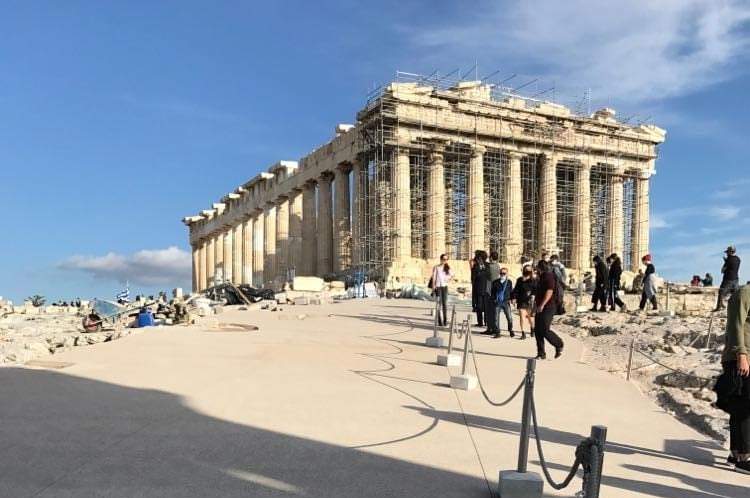Athens, concrete on the Acropolis: controversy rages over new access roads
There is controversy in Athens over the new face that theAcropolis has taken on a few weeks ago: new access routes have in fact been built on the site to allow greater accessibility for tourists, especially those with disabilities, but archaeologists are protesting because of theinvasiveness of the intervention. The announcement had been made by Greece’s Ministry of Culture in late October 2020: the goal of the project was to improve visiting conditions. At first it seemed that the intervention was simply a kind of “upgrade” of the old visitor routes to allow easier access to the Acropolis by the disabled, but the problem is that a concrete pour has arrived on the Acropolis rocks that has infuriated archaeologists: the criticism is that the intervention has hidden other purposes (for example, to allow a more massive influx of tourists in the summer period) and that it has altered the appearance of the Acropolis, damaging it.
Criticism concerns the materials used and the aesthetic appearance of the interventions, which as seen in the photographs clash with the appearance of the archaeological site. Moreover, according to some, the damage is even irreversible. And that is not all: in fact, it seems that these works are only the first phase of a further transformation. In fact, the Acropolis Monument Preservation Committee (ESMA) has announced that a restoration of the access roads to the Acropolis, compesa a marble staircase from the first century A.D., will soon begin, and there are those who now fear invasive interventions even on portions of the site that have so far been spared from the works.
Renowned Greek archaeologist Yannis Hamilakis, a professor at Brown University in Providence in the United States, wrote a scathing post on Facebook in early March, then launched an appeal that was signed by several archaeologists. “Objections were expressed that the installation of all these new buildings and interventions would erase any sense of historical unity and continuity,” Hamilakis recalls. “Furthermore, it has not gone unnoticed that these ongoing new constructions, let alone future ones, have been implemented by completely circumventing Greece’s international and national legal frameworks and institutional standards.” Controversy also surrounds the announced renovations: “The press release of the Greek Ministry of Culture and Sports,” Hamilakis points out, “stated that a new marble staircase will be built, modeled on a Roman staircase from the 1st century AD. The result will be a stepped plaza that will start from the lower limit of the western slope of the Acropolis and go up to the western front of the Propylaea, and will allow crowds of tourists to enter between the columns and pass through the monument to finally reach the floor of the Acropolis.”
All these interventions, Hamilakis concludes, “are contrary to internationally recognized and established principles of protection, conservation and preservation of antiquities. On the contrary, they open to the devaluation, concealment and degradation of the greatest archaeological and artistic treasure bequeathed to modern Greece, to which humanity entrusts its preservation.”
The demand of Hamilakis and the many who have signed his appeal is that the pavement be removed, that the announced projects be canceled, and that projects be implemented that respect the natural landscape, peacefully coexist with the rock and architecture, solve the problems generated by visitor flows, while providing easier access for people with disabilities and supporting the ongoing restoration work. “These valid reasons,” says Hamilakis, “should not be selectively used as a pretext for arbitrary interventions that are hastily implemented.” Finally, calls are made for the immediate organization of an administrative review to study the numbers of tourist flows so that maximum numbers of visitors that can be safely accommodated on the Acropolis can be established, and for more openness to dialogue, which Hamilakis says has not been there.
Greece’s response came to Hamilakis through ESMA, which disputed the contents of Hamilakis’ appeal, saying that the new flooring is easily reversible and that the interventions on the access to the Propylaea will aim to return the staircase to its original form, with a project that will be based on “exhaustive archaeological and architectural documentation.” Moreover, again ESMA said that the ancient remains will not be covered but will remain visible and accessible.
Photo by Yannis Hamilakis shows the new access road to the Acropolis.
 |
| Athens, concrete on the Acropolis: controversy rages over new access roads |
Warning: the translation into English of the original Italian article was created using automatic tools. We undertake to review all articles, but we do not guarantee the total absence of inaccuracies in the translation due to the program. You can find the original by clicking on the ITA button. If you find any mistake,please contact us.




























